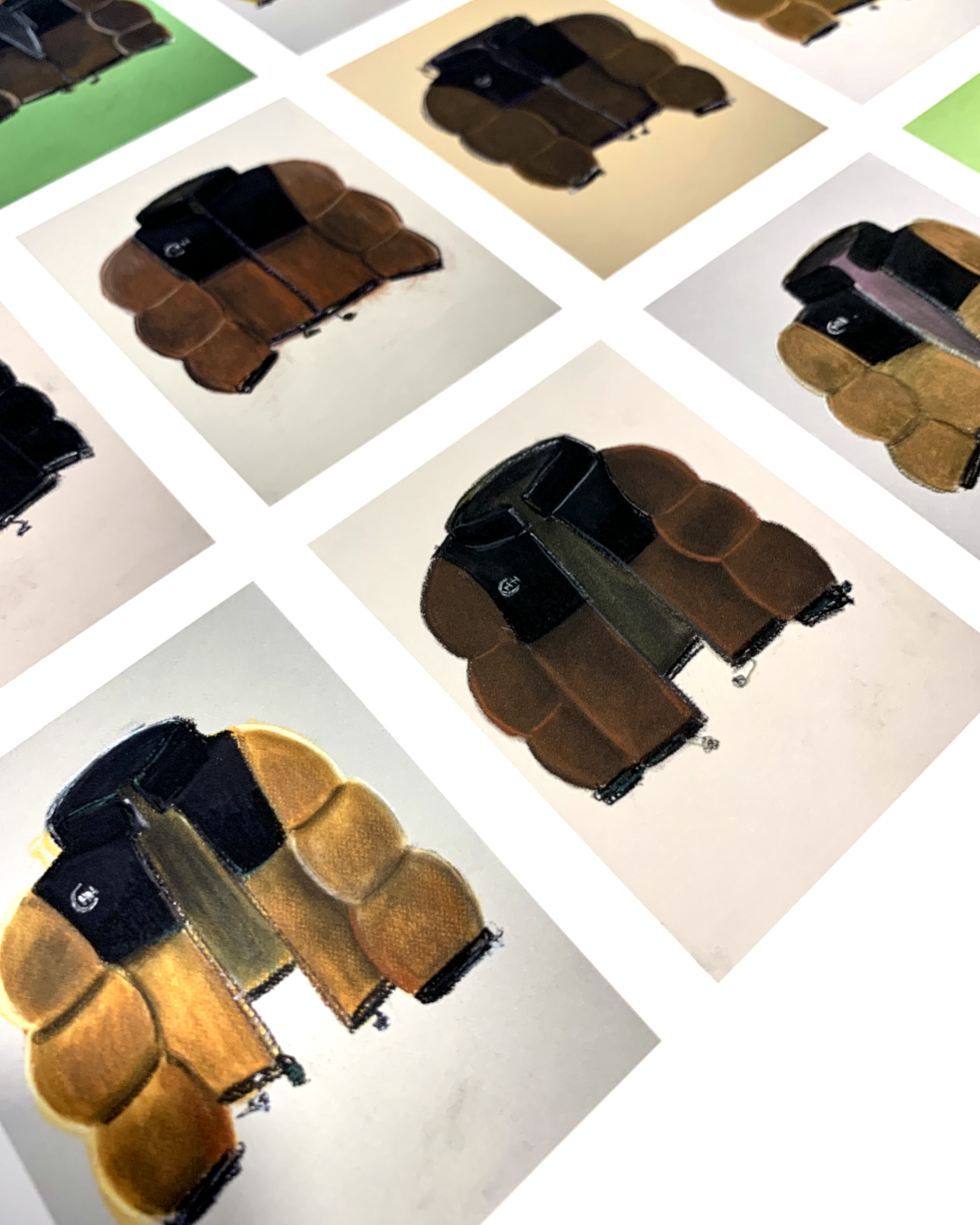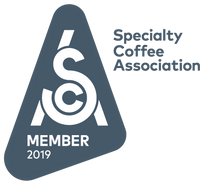
In Conversation | Fleur Yearsley
From
From £46.60 GBP
Recently Hundred House Coffee director Anabelle de Gersigny went to visit current Art + Industry artist Fleur Yearsley. Here they chat through her work, from memory to symbolism, humour through to her studio set up.
Ghosted (2022) was one of the works we first fell in love with - can you talk us through this piece? Perhaps it's also a interesting work to think through personal symbolism and shared contemporary cultural references within your practice and how these find their balance?
Standing on an unsuspected object can be a common experience felt by many. Ghosted is an evocative painting of a figure stepping onto a discarded piece of Lego. A freeze frame captured at the point of no return. The comically socked foot hovers over an impenetrable building block, connected to an unwary person just out of frame. The themes in my work usually centre around introspective moments or something on the cusp of happening evoking anticipation and apprehension.

The brightness of the red Lego block signifies a warning, but humorous in nature as it hasn’t been spotted. I play with a complimentary colour palette, a range of hues and balance which can be at odds with the painful reaction to the image. ‘Ghosted’ brings a wave of nostalgia for our eclectic collections of iconic toys. The palm tree and ghost, disparate in their relationship to one another, stand in like actors off centre stage with a sense of uncanniness.
I try to imbue energy into the work by contrasting flat colour, detail, nuances, drawing and gestural painting techniques that create a vibration in the paintings. They are suspended happenings, perhaps have come to life all at once and reflect on my experience as a millennial and living in cities that are in constant flux. References in the work to pop culture seek to find commonalities with others, giving ownership and speaks to a common language that can foster empathy by reassuring us certain sensations are also felt by others and we’re not alone.
You've mentioned mortality before, in reference to captured moments or memories as the subject matter within your paintings. Can you talk us through that in a bit more detail?
Memories are the genesis to my paintings. A springboard to jump into structuring paintings that are loaded with references, symbolism and playfulness. The momentum is to get the work to resonate and for people to feel seen by finding shared collective experiences that connect. I paint everyday occurrences that may be accessible and approachable for the viewer. In my paintings mortality is involved by the subjects possessing a vulnerability. There’s a certainty that these moments are fleeting, but still a buoyancy in spite of grief as I paint with immediacy to capture them.

In terms of the works you have created for Hundred House - if we start with Rendezvous - how did you approach making this work, and in particular, in relation to a collaboration with Hundred House? How did you apply your process to the commission?
Rendezvous was inspired by essentially looking out of my studio window in Manchester. There’s always so much building work and development taking place in the city. The subjects of my paintings can often stand in for people, characterful and bodily in presence. Giving agency to two cranes high in the sky, pausing work and deep in exchange intrigued me. Taking time to connect, their hooks almost touch in a charged interaction that instils tension and suspense. I wanted to render the cranes with a simple linearity that gives them presence and strength yet have the contradistinction of being painted in sunset colours, so they also retain a softness and fragility.
The process of creating the works for the commission started as my work always does with words, as I wrote down what I connotate with coffee. I did this whist thinking about its sensations and incorporating subjects what have a relation to my practice. After this I made a load of sketches to refine the compositions to their simplest form, to take what is essential and find first person viewpoints that may be overlooked. During this process I think about scale and how I want the viewer to interact with the painting. Then I made numerous pastel and watercolour studies which remain open and loose so that when I get to the making, the image is still fresh and there’s vivacity in the process and details to explore.

Your work strikes a chord with a generation - can you tell us a bit about your studio, the community you work within and how this permeates your work?
I moved back to Manchester after 6 years of living in London to study and work. The city had changed so much since I had lived here and felt overwhelming to start building an art community again. The invitation to Paradise Works was an exciting shift and welcome into the Manchester art scene as the artist led studios are actively engaged and supportive.
There are around 40 of us in a 3-storey mill on the river Irwell. We have 2 galleries and hold regular open studios, meetings and gatherings for socials that creates a togetherness which is invaluable as an artist. Working in the studio can at times be an insular process. I’m reluctant to make art in a vacuum and feel impassioned to connect to other artists and make with a strong sense of sociology. Since moving I feel that northern humour has played out a lot more in the work with a deeper exploration of high/low culture, pop culture iconography, identity and gender.
There is a lot of humour in your work - looking towards pieces like Gotta Lotta Baggage (2023) and Grim (2023), it's this beautiful play on words and bold imagery - can you tell us a bit more about where this humour comes from, how implicit the titles are to you work?
An untitled artwork can be a missed opportunity. A title may be employed as an entry way in for the viewer, into the headspace of the artist, a narrative or voice. Titles are very important in my practice and can come before, during or after the work is finished. Sometimes it clicks straight away other times it unfolds slowly. The titles can reflect my disposition by injecting the painting with absurdity and satire. I like to play on words, so they have multiple meanings and subvert familiar phrases.
We really love your works where you use a lot of repetition, grids like Hug (2023) and All the plants I've over loved (2023). These are particularly interesting when thinking about memory, finding poignancy in the banal or day-to-day. How do these work differ to your larger scale paintings and what do they highlight in your work?
Working in grids and sequentially can consolidate a body of work, by conveying the diversity or variation of a subject matter. The formation has a strong link to the history of pop art and can be used to group works together that have an overarching theme and reinforce the absurdity in terms of the amount of choice there is an artist.
There’s a different tempo to the works on paper in the fact that I can make them quickly and retain an explicit drawing element that feels sensitive and free. Soft pastels especially can have rich pigments that give the paintings depth and vibrancy. You can layer them immediately and build up the image without waiting for it to dry. Making these works can encourage me in the larger paintings to take more risks and connect to sensibilities that may be multifaceted in addition to reflecting the human experience.
Which work or collection would you say was a defining moment for you, when you felt you had distilled your visual language?
I feel like there was a considerable shift in my work whilst on a residency last year in France. Having time away from my usual studio approach and making patterns allowed me to consider and refine what my core values are. These have become vital to veracity of my practice and include humour, directness, pop culture iconography, vulnerability and openness.

Can you talk us through scale in your work - how this plays a role in how we read the works, how seemingly commonplace objects are given new meaning through this aspect?
I’m always thinking about scale in my work. Depending on what I’m trying to depict, it may be important for the intimacy to be implicit or the painting to envelop and immerse the viewer so that it’s an environment they become a part of. The larger-than-life objects can become characters themselves, protagonists in a play and stand in for the body just out of frame.
I remember a tutor at Slade saying that a small painting is intellectual and a large painting romantic. My relationship to a small painting is the feeling that there’s nowhere to hide. It’s a different approach and movement of the body. No matter what the scale of works, I always try to reach a point where the art can be entered and spacious enough to have powerful social and personal individual meanings.
What's your favourite colour?
I have a real affinity with chalk green, tranquil and relaxing. Yet how we see and process colour is so much about what it is contrasted with. Joesph Alber’s book Interaction of Colour was influential to this learning. I especially love a green/pink combo.
What do you listen to when you're working?
All sorts really depending on what I’m doing in the studio and mode I’m in. Podcasts, audiobooks, and music. I always have something playing.
Tea or coffee?
Don’t know where I would be without coffee in the morning.






